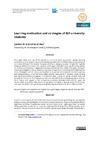Please use this identifier to cite or link to this item:
https://accedacris.ulpgc.es/jspui/handle/10553/70343
| Title: | Learning motivation and strategies of ESP university students | Authors: | González Ardeo, Joseba M. | UNESCO Clasification: | 570107 Lengua y literatura 550510 Filología |
Keywords: | English Learning Motivation English Learning Strategies English for Specific Purposes (ESP) ESP courses Engineering students, et al |
Issue Date: | 2016 | Journal: | LFE. Revista de Lenguas para Fines Específicos | Abstract: | This paper deals with two of the key factors in the L2 learning process, namely, learning
motivation and strategies. A group of engineering students from Bilbao (Spain) having a good
command of English for General Purposes (EGP) and taking a course in English for Specific
Purposes (ESP) are the basis of a study in which types of English Learning Motivation (ELM),
i.e. intrinsic and extrinsic (integrative and instrumental) (Brown, 2000), and types of English
Learning Strategies (ELSs), i.e. memory, cognitive, compensation, metacognitive, affective and
social strategies (Oxford, 1990), are analysed. As expected, Instrumental ELM and Cognitive
and Metacognitive ELSs are the most widely used by these learners. However, some striking
and significant differences appear in connection with: 1) male vs female Intrinsic ELM and
Social ELSs; 2) 21-23 vs 24-27 age group Instrumental (EGP) ELM, and Metacognitive and Social
ELSs. Finally, with respect to the prospective correlation between ELM and ELS types, the
results seem to confirm that there are significant correlations among most of them; e.g.,
Instrumental (ESP) ELM is positively and significantly correlated with all but Affective ELM. El artículo se ocupa de dos de los factores clave en el proceso de aprendizaje de una segunda lengua, a saber, las estrategias y la motivación para aprenderla. Un grupo de estudiantes de ingeniería de Bilbao (España) que tienen un buen dominio del Inglés para Fines Generales (IFG) y que están recibiendo un curso de Inglés para Fines Específicos (IFE) es la base de un estudio en el que se analizan tipos de motivación para el aprendizaje del inglés (MAI), es decir, intrínseca y extrínseca (integradora e instrumental) (Brown, 2000), y tipos de estrategias de aprendizaje del inglés (EAI), es decir, se analizan estrategias relacionadas con la memoria, cognitivas, de compensación, metacognitivas, afectivas y sociales (Oxford, 1990). Como era de esperar, las más ampliamente utilizadas por estos alumnos son la MAI instrumental y las EAI cognitivas y metacognitivas. Sin embargo, se dan algunas diferencias llamativas y significativas relacionadas con: 1) La MAI intrínseca y las EAI sociales para varón vs hembra; 2) La MAI instrumental (IFG) y las EAI metacognitivas y sociales para los grupos de edad 21- 23 vs 24-27. Finalmente, con respecto a la correlación entre tipos de MAI y de EAI, los resultados parecen confirmar que hay correlaciones significativas entre la mayoría de ellas; por ejemplo, la MAI instrumental (IFE) está positiva y significativamente correlacionada con todas las MAI excepto la afectiva. |
URI: | https://accedacris.ulpgc.es/handle/10553/70343 | ISSN: | 1133-1127 | DOI: | 10.20420/rlfe.2016.0094 | Source: | LFE. Revista de lenguas para fines específicos [eISSN 2340-8561], v. 22 (1), p. 141-169 |
| Appears in Collections: | Artículos |
WEB OF SCIENCETM
Citations
6
checked on Jun 8, 2025
Page view(s)
305
checked on Mar 2, 2024
Download(s)
282
checked on Mar 2, 2024
Google ScholarTM
Check
Altmetric
Share
Export metadata
Items in accedaCRIS are protected by copyright, with all rights reserved, unless otherwise indicated.
